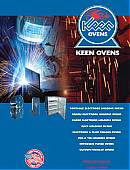Industrial Ovens
Front-Loading
![]() Under 10 cubic feet
Under 10 cubic feet
![]() 10-20 cubic feet
10-20 cubic feet
![]() Over 20 cubic feet
Over 20 cubic feet
![]() See All
See All
Top-Loading
![]() Under 10 cubic feet
Under 10 cubic feet
![]() 10-20 cubic feet
10-20 cubic feet
![]() Over 20 cubic feet
Over 20 cubic feet
![]() See All
See All
Learn About Our Industrial Ovens
Welding Ovens
![]() CONEX Storage
CONEX Storage
![]() Stick Electrodes
Stick Electrodes
![]() Sub-Arc Flux
Sub-Arc Flux
![]() Wire Spools
Wire Spools
![]() Tig Filler Wire
Tig Filler Wire
![]() Multi-Purpose
Multi-Purpose
![]() Nitrogen Purge
Nitrogen Purge
![]() See All
See All
 Order Our Free Catalog Today Click Here |
| Available Inventory |
Flux-Cored Arc Welding TechniquesThe techniques used in flux-cored arc welding are much the same as those used in other welding methods—especially MIG welding. The electrode type, the flux type, the metal thickness, and the welding position will help determine which technique might work best on a certain project. Backhand TechniqueThe backhand technique is often used with self-shielded flux-cored arc welding. This technique is achieved by passing the electrode along the welding site in the direction opposite that of welding. When using the backhand technique, the handle of the welder is dragged like a stick welder. This technique works well when welding in the flat and horizontal positions. It may also be an option when welding in the 4G position to avoid being hit by spatter. The backhand welding method creates a weld that is high and narrow—one that penetrates deeply. A disadvantage of using the backhand technique is that the weld puddle is a bit harder to see. As in stick welding, you need to keep an eye on the weld puddle size behind the crater. Forehand TechniqueThe forehand welding technique is often used with gas-shielded flux-cored arc welding. The forehand process requires the electrode to be moved along the work site in the same direction as the welding. The forehand method is often used when working with thinner metals. It may be the best method to use when welding in the vertical up position and for overhead fillet welds (4F). The forehand technique can also be used in the flat and horizontal positions. Unlike the backhand method, the forehand welding technique makes it easy to see the weld puddle. As a result, it is also easier to see the weld joint and to keep from wandering off the joint. With the forehand technique, it is important to try to keep the travel angle just right, so as to prevent excessive accumulation of spatter. Stringer Bead and Weave Bead TechniquesThe stringer bead welding technique is one in which the weld beads are deposited in a straight line. When using the weave bead technique, the weld beads are deposited in a zigzag formation. The forward weld travel speed of the stringer bead method is faster than that of the weave bead method. This faster travel speed reduces the amount of heat input, which is desirable when welding T-1 steels. The straight bead technique works well in any position. If welding in the vertical position, however, a partial weave may be preferable. Although the partial weave can make the welding process easier in this position, the weave total should not exceed twice the electrode diameter. In FCAW, the stringer bead method is more commonly used. The weave bead method may be used occasionally, but most flux cored electrodes are designed for stringer beads.
Related Article - Flux-Cored Wire versus Solid Wire Learn more about Submerged ARC Flux What is Flux-Cored Arc Welding? How Flux-Cored Arc Welding Works
|